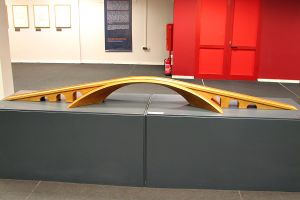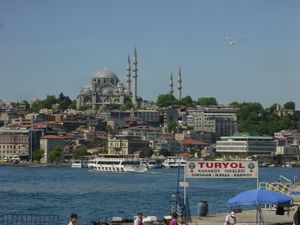القرن الذهبي
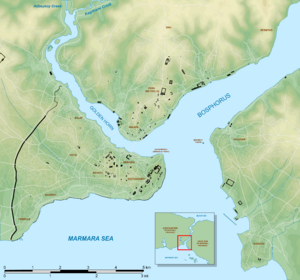
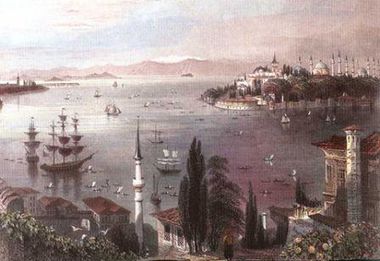
القرن الذهبي عباره عن شبه جزيرة في أسطنبول وتقع فيها قصر الباب العالي ومسجد السلطان أحمد وأيا صوفيا. يقسّم هذا المصبّ على هيئة قرن إسطنبول الأوروبية . وهو إحدى أفضل الموانئ الطبيعية في العالم، كان في السابق مركز للقوات البحرية البيزنطية والعثمانية ومصالح الشحن التجارية.
اليوم، تخطّط المتنزهات الجذّابة والساحرة على شواطئ القرن الذهبي مشهد رائع خصوصا بينما تهبط الشمس على الماء. في فينير وبالات، أحياء نصف الطريق فوق القرن الذهبي، هناك كامل الشوارع ملأت بالبيوت الخشبية القديمة،والمساجد والكنائس. العثمانية و البيزنطية. يستقرّ النظام البيزنطي في فينير ... أما العثماني فأعلى القرن الذهبي في يوب، وهناك بعض الأمثلة الرائعة للهندسة المعمارية العثماني يأتي المسلمون من جميع أنحاء العالم يزور توب كابي سراي ((مسجد وقبر أبو أيوب الأنصاري )) وهو أحد الأماكن المشهورة. إنّ المنطقة ما زالت مكان دفن شعبي، والتلال فوق المسجد منقّطة بشواهد القبور الحديثة بعثرت بالأحجار العثمانية المزخرفة. مقهى لوتي بيير، في أعلى التلّ الذي يطلّ على الضريح والقرن الذهبي، مكان رائع للتمتّع بهدوء ومشاهدة خليج القرن الذهبي .
. . . . . . . . . . . . . . . . . . . . . . . . . . . . . . . . . . . . . . . . . . . . . . . . . . . . . . . . . . . . . . . . . . . . . . . . . . . . . . . . . . . . . . . . . . . . . . . . . . . . . . . . . . . . . . . . . . . . . . . . . . . . . . . . . . . . . . . . . . . . . . . . . . . . . . . . . . . . . . . . . . . . . . . .
الوصف
القرن الذهبي هو مصب غمرت في فترة ما قبل التاريخ. وهو بطول 7،5 كم، وعرض 750 مترا في أوسع نقطة. حيث يصب في البوسفور، بإتساع حوالي 35 مترا. وهو اليوم موزع على أربعة جسور. , نقل المصب، وجسر حليش (حرفيا جسر القرن الذهبي)، وجسر غلطة Eski (حرفيا «غلطة» الجسر القديم، وجسر غلطة السابق تم نقل هنا في القطع، وإعادة تجميعها والمستعادة بعد تلفه في حريق في عام 1992 أنه، جسر غلطة الحالي الذى حل محله وتم الانتهاء منه في عام 1994)، و(انكوباني) جسر أتاتورك، و جسر غلطة. الجسر الخامس هو قيد البناء حاليا لربط خطوط لمترو الانفاق من مترو اسطنبول إلى الشمال والجنوب من القرن الذهبي.[1]
التاريخ
The Golden Horn (Keras) forms a deep natural harbor for the peninsula it encloses together with the Sea of Marmara. The Byzantine Empire had its naval headquarters there, and walls were built along the shoreline to protect the city of Constantinople from naval attacks. At the entrance to the Horn, there was a large chain pulled across from Constantinople to the old Tower of Galata (which was known as the Megàlos Pyrgos, Great Tower, in Greek among the Byzantines) on the northern side, preventing unwanted ships from entering. This tower was largely destroyed by the Latin Crusaders during the Fourth Crusade (1204), but the Genoese built a new tower nearby, the famous Galata Tower (1348) which they called Christea Turris (Tower of Christ).
There were three notable times when the chain across the Horn was either broken or circumvented. In the 10th century the Kievan Rus' dragged their longships out of the Bosporus, around Galata, and relaunched them in the Horn; the Byzantines defeated them with Greek fire. In 1204, during the Fourth Crusade, Venetian ships were able to break the chain with a ram. In 1453, Ottoman Sultan Mehmed II, having failed in his attempt to break the chain with brute force, instead used the same tactic as the Rus', towing his ships across Galata into the estuary over greased logs.
After the Capture of Constantinople in 1453 by Mehmed the Conqueror, Greeks (Greek Orthodox Church), Jews, Italian merchants, and other non-Muslims began to live along the Horn in the Phanar (Fener) and Balat districts. Today the Golden Horn is settled on both sides, and there are parks along each shore. The Istanbul Chamber of Commerce is also located along the shore, as are Muslim, Jewish and Christian cemeteries. The Galata Bridge connects the districts of Galata and Eminönü. Until the 1980s the Horn was polluted with industrial waste, but it has since been cleaned up.[2] Today its history and beauty make it a popular tourist attraction in Istanbul.
جسر ليوناردو
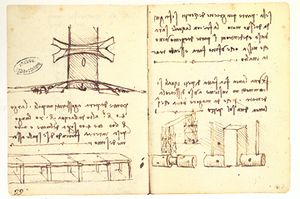
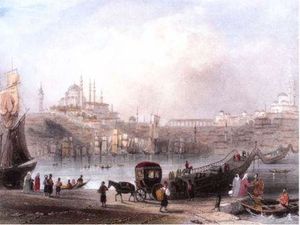
In 1502 Leonardo da Vinci produced a drawing of a single span 720-foot (240 m) bridge over the Horn as part of a civil engineering project for Sultan Bayezid II. The vision was resurrected in 2001 when a small footbridge of Leonardo's design was constructed near Ås in Norway.
On May 17, 2006, it was announced that the prime minister of Turkey Recep Tayyip Erdoğan and the mayor of Istanbul Kadir Topbaş had decided to resurrect the Leonardo da Vinci Bridge project. The urban planning and feasibility studies of the project had started earlier, in 1999. After five centuries, Leonardo da Vinci's bridge will span the Golden Horn, becoming the first architectural project of the Renaissance genius to be realized in its original scale and its planned location.
The Turkish architect in charge of the construction is Bülent Güngör, known for the restoration of the Çırağan Palace, the Yıldız Palace, and the Sümela Monastery. The bridge will be an exact realisation of da Vinci's design, with a single span of 720 feet (240 m), a width of 8 metres, and a height above the Golden Horn of 24 metres, as shown on his sketches.
الأدب
The Golden Horn features in many works of literature dealing with classical themes. For example, G. K. Chesterton's poem Lepanto contains the memorable couplet "From evening isles fantastical rings faint the Spanish gun, And the Lord upon the Golden Horn is laughing in the sun".
أنظر أيضًا
مراجع
روابط خارجية
| القرن الذهبي
]].Coordinates: 41°01′45″N 28°57′40″E / 41.02917°N 28.96111°E





